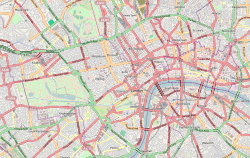
Back Britse Museum Afrikaans Bryttisc Museum ANG المتحف البريطاني Arabic المتحف البريطانى ARZ Muséu Británicu AST Britaniya Muzeyi Azerbaijani Museum British BAN Брытанскі музей Byelorussian Брытанскі музэй BE-X-OLD Британски музей Bulgarian
 | |
 Aerial view of the British Museum in 2015 | |
| Established | 7 June 1753 |
|---|---|
| Location | Great Russell Street, London WC1B 3DG, England |
| Collection size | Approx. 8 million objects[1] |
| Visitors | 5,820,860 (2023;[2] up 42% from 2022) |
| Chair | George Osborne |
| Director | Nicholas Cullinan |
| Public transit access | |
| Website | britishmuseum |
| Area | 807,000 sq ft (75,000 m2) in 94 galleries |
The British Museum is a public museum dedicated to human history, art and culture located in the Bloomsbury area of London. Its permanent collection of eight million works is the largest in the world.[3] It documents the story of human culture from its beginnings to the present.[a] Established in 1753, the British Museum was the first public national museum.[4]
In 2023, the museum received 5,820,860 visitors, an increase of 42% from 2022. It was the most popular attraction in the United Kingdom according to the Association of Leading Visitor Attractions (ALVA).[2]
At its beginning, the museum was largely based on the collections of the Anglo-Irish physician and scientist Sir Hans Sloane.[5] It opened to the public in 1759, in Montagu House, on the site of the current building. The museum's expansion over the following 250 years was largely a result of British colonisation and resulted in the creation of several branch institutions, or independent spin-offs, the first being the Natural History Museum in 1881. Some of its best-known acquisitions, such as the Greek Elgin Marbles and the Egyptian Rosetta Stone, are subject to long-term disputes and repatriation claims.[6][7]
In 1973, the British Library Act 1972[8] detached the library department from the British Museum, but it continued to host the now separated British Library in the same Reading Room and building as the museum until 1997. The museum is a non-departmental public body sponsored by the Department for Culture, Media and Sport. Like all UK national museums, it charges no admission fee except for loan exhibitions.[9]
- ^ "Collection size". British Museum. Archived from the original on 12 August 2017. Retrieved 22 July 2016.
- ^ a b "British Museum is the most-visited UK attraction again". BBC News. 18 March 2024. Archived from the original on 18 March 2024. Retrieved 18 March 2024.
- ^ van Riel, Cees (30 October 2017). "Ranking The World's Most Admired Art Museums, And What Big Business Can Learn From Them". Forbes. Archived from the original on 18 May 2023. Retrieved 18 May 2023.
- ^ "History of the British Museum". The British Museum. Archived from the original on 9 October 2016. Retrieved 12 July 2018.
- ^ "The Life and Curiosity of Hans Sloane". The British Library. Archived from the original on 19 November 2018. Retrieved 21 October 2017.
- ^ "The Big Question: What is the Rosetta Stone, and should Britain return". The Independent. 9 December 2009. Archived from the original on 11 March 2018. Retrieved 2 April 2020.
- ^ Tharoor, Kanishk (29 June 2015). "Museums and looted art: the ethical dilemma of preserving world cultures". The Guardian. Archived from the original on 10 June 2020. Retrieved 18 April 2018.
- ^ "British Library Act 1972". legislation.gov.uk. 1972. Archived from the original on 8 August 2022. Retrieved 22 July 2022.
- ^ "Admission and opening times". British Museum. 14 June 2010. Archived from the original on 8 July 2016. Retrieved 4 July 2010.
Cite error: There are <ref group=lower-alpha> tags or {{efn}} templates on this page, but the references will not show without a {{reflist|group=lower-alpha}} template or {{notelist}} template (see the help page).
